
中英文化交流战略合作与实际操作
由于2015年是中英文化交流年,许多文化活动都在规划并实施中。2014年12月7日在上海召开的“中英文化交流:战略合作与实操”就是其中的一个。它同时也是创办”全球中国对话“系列论坛的筹备会议。本次活动邀请了各界人士讨论了相关议题。
日期:2014年12月7日(周日)
时间:2:30—5:30
地址:上海徐汇区百色路100号格兰云天大酒店会议室(近龙吴路)
主办单位:
- 全球中国比较研究会(英国)
- 全球青年企业家协会(英国)
协办单位:
- 复旦大学社会文化人类学研究中心
- 浙江传媒学院话语与传播研究中心
承办单位:上海觉尘文化传播有限公司(SENSO:组织策划及承办中外文化交流活动,为文化传播和对外文化交流提供服务)
赞助单位:上海全丰投资有限公司

组织者:赵梦女士(觉尘文化)
主持人:张乐天教授(复旦大学)
主讲人:常向群教授(全球中国比较研究会;伦敦大学亚非学院)
论题:
- 中国的“文化搭台,经贸唱戏”模式是否能在海外推广成功?
- “文化搭台,经贸唱戏”之间的关系如何?
- 为什么有观点认为“文化搭台,经贸唱戏”不是真正的文化交流,而是经济绑架文化的表演?
- 中国近代开始的现代化进程中的经验教训对世界各国现代化进程的意义如何?
- 中国经验如何帮助研究欧洲?
- 如何策划中英文化交流战略合作?
- 中英文化交流实际操作例举
流程:
14:30—14:45 签到、自由交流
14:45—14:50 主持人致辞介绍嘉宾
14:50—15:10 主讲人介绍中英文化交流及中国学术全球话等背景和具体问题
15:10—17:00 与会者每人3分钟对不同论题发表自己的看法
17:00—17:20 互动环节
17:20—17:30 小结

复旦大学社会发展与公共政策学院前副院长、复旦大学社会文化人类学研究中心主任、全球中国比较研究会共同会长张乐天教授(左)主持了这次上海预备会。他首先介绍了自己的三大研究领域:人民公社制度研究,引进社会工作课程,创办社会生活资料中心,认为这些都可以用来作比较研究。之后,全球中国比较研究会(英国) 会长、伦敦大学亚非学院中国研究中心研究员常向群教授作了主题发言,主要介绍中国比较与中国研究的区别,为什么把中国研究放在全球框架中来做,怎样把对中国社会研究的成果加入到人类的知识大厦,在做学问的同时如何从跨学科到跨行跨界的知识转化,不但服务学术社区,而且要参与型塑全球社会。
来自上海及杭州的20多名专家、学者及从业人士参加了这次会议,发言的与会嘉宾自然地形成了以下三个小组。

民进上海市人口资源环境委员会副主任、高级经济师施薔生先生(左一),也是这次上海预备会议的主要协调人,他在发言中概括了中英文化交流的五大特点及其意义,强调利用中国比较研究这一抓手,在学术外宣的凸现中国元素。上海全丰投资有限公司是这次上海预备会的主要赞助者,其董事长錢振华博士(左二)讲道,从商业文化的体验中,感受到人们在做生意或其他事情上所表现出来的自私、不守规矩等的做法,开始以为是文革遗毒,后来发现在民国、清朝、战国时期都有,因此作为中国文化和中华文明中的大问题来反思,其文化基因到底是什么?虽然他在北大读书期间聆听了许多大师的讲座,但是,对这个问题没有令人满意的解答。丁正伟先生(右二)是一位艺术评论家,他认为文化交流的过程不是抢话语权,影响或改变别人,而是要柔和地慢慢地渗透,通过问道求野的礼,达到上善若水、天人合一的境界。上海文艺出版社 副总编曹元勇先生(右一),提出要用故事来讲概念,如莫言的作品的特点是讲述底层人的故事以及他们如何思考问题的。还有如何把文化用文明讲,天下一体的全息概念、中庸思想,在与其它文明的交流中应该探讨合适的讲法。

华东理工大学商学院制度与战略研究中心主任、中国社会学会社会网专业委员会副会长郭毅教授(左一),也提出了一个中国概念输出的问题,如在管理研究与教学过程中有阴阳、关系等概念,如何综合大陆港台的思想行为的建构研究,解析中国的概念。浙江传媒学院话语与传播研究中心主任、中国话语分析研究协会常务理事钱毓芳教授(左二)是语料库专家,她提出可以通过建立社会科学语料库的方式,通过批判话语的方法,来帮助中国概念和输出和中华话语的建构。上海交通大学老子书院院长王干城教授(右二),在大学学了七年的西方哲学,转入中国传统文化的研究,从中挖掘出老子思想,认为其精华在于12个字:生而不有、为而不恃,长(掌)而不宰,认为这与林肯的民有、民治、民享的观点一一对应。后来成立老子书院,对企业家进行传统文化的培训。孙晓婧女士(右一)是罗滕发展协会的理事长和罗藤企业品牌管理有限公司总裁,她介绍自己在英国布里斯托大学留学期间,参与了全球中国比较研究会的工作,回国创办协会和企业的同时也自觉从事公益事业,开展活动帮助贫困孩子就学。

上海财经大学人文学院经济社会学系副主任陆绯云教授(左一)早在上个世纪90年代就参与了英国社会经济研究委员会资助的关于社会支持的项目,与常向群同是项目组成员。她认为如何向世界说明中国要对文化作分解:日常生活中的文化、费孝通提出的文化自觉、文化创意产业、中华文化话语等等。费孝通的“美美与共天下大同”的观念有助于文化交流。上海社会科学院商业研究中心主任朱连庆研究员(左二)最近刚从英国回来,他介绍说,我们把眼睛向外看的时候,要看深层的东西,如英国人在商业运营时平心静气、理智行事,最后大家各得其所,社会也稳定,要探讨这后面的民族精神和民族基因。复旦大学新闻学院信息与传播研究中心副主任殷晓蓉教授(中),曾经翻译过传播学史,从全球的社会变迁进程看传播问题,中国新闻走出去很难,国家有投入,还有互联网、新媒体、自媒体等等,研究如何使用不同的媒介,如少数民族的媒介,很重要。北京大学出版社副编审、上海圣大燕园文化传播公司总经理王业龙先生(右二), 认为文化交流是双向的,但是我们实际情况是很不平衡的,出国留学的多,引进的版权多,输出的少。新文化运动100年了,正在编中英文化交流的书,希望能够走出去。最后,中国人民大学社会学理论与方法研究中心副研究员、郑杭生社会发展基金会副秘书长李战刚博士(右一),主要谈了两个问题,一是介绍郑杭生基金会对青年学人的赞助和“爱心基地”的建设,二是介绍郑杭生教授关于中国经验研究的方法与理论,如长波进程的时间和本土的两个维度,通过传统到现代的脉络来把握把全球化进程,等等。

会前,部分与会者翻阅全球中国比较研究会和环球世纪出版社彩单,左上图左二这位先生是做营销策划的,他代表上海外国语大学语言研究院的赵蓉晖教授、余华博士和沈骑博士参会,他们因会议时间冲突未能与会。右上图为全球中国比较研究会的两位会长(前排左右)及其中国首席代表、艾语·希捷集团 (研究|咨询|交流) 执行董事、高级顾问章简博士(后排中间)。会后,与会者们亲切交谈,下图为常向群与本次预备会议的组织者、上海觉尘文化传播有限公司策划人赵梦女士(左)合影。

以上是这次上海预备会议的主要组织和筹办者。

部分嘉宾和与会者合影留念,之后并继续聚叙。
以上由茱莉亚·余根据觉尘文化提供的照片和录音编辑整理。
点击这里见英文页面

A Symposium on China-British Cultural Exchange: Strategic Cooperation and Practical Implementation
As 2015 is the year of China-UK cultural exchange, many cultural activities are being planned and implemented. The symposium on ‘China-UK Cultural Exchange: Strategic Cooperation and Practical Implementation’ held in Shanghai on December 7, 2014, is one such event. It also served as the preparatory meeting for the establishment of the ‘Global China Dialogue’ series of forums. This event invited people from various fields to discuss relevant topics.
Date: Sunday, December 6, 2014
Time: 2:30–5:30 pm
Address: Conference Room of the Grand Skylight Hotel, 100 Baise Road, Xuhui District, Shanghai
Organizers
- CCPN Global (UK)
- The Young Entrepreneur Society (YES Global)
Co-organizers
- Research Center for Socio-cultural Anthropology, Fudan University
- Research Center for Discourse and Communications, Zhejiang University of Media and Communications
Hosting organizer: Shanghai Juechen Cultural Communications Co., Ltd. (SENSO: plans and organizes Chinese-foreign cultural exchange activities, provides services for cultural promotion and cultural exchange outreach)
Sponsor: Shanghai Quan Feng Investment Co., Ltd.

Organizer: Ms ZHAO Meng (SENSO)
Chair: Professor ZHANG Letian (Fudan University)
Speaker: Professor Xiangqun Chang (CCPN Global; SOAS)
Topics
- Can China’s model of “Culture builds the stage; commerce performs the show” be successfully promoted abroad?
- What is the relationship between “culture building the stage” and “commerce performing the show”?
- Why do some perspectives view “Culture builds the stage; commerce performs in the show” not as true cultural exchange but as a display of economics hijacking culture?
- What is the significance of the experience and lessons of China’s recent modernization for the modernization processes of countries all over the world?
- How does the Chinese experience aid in the study of Europe?
- How should strategic cooperation for China-British cultural exchange be planned?
- Examples of practical implementation of China-British cultural exchange
Schedule
14:30—14:45 Registration, networking
14:45—14:50 Chair delivers address and introduces special guests
14:50—15:10 Speaker gives introduction to China-British cultural exchange and Chinese academic globalization
15:10—17:00 Conference participants have 3 minutes each to share their perspectives on different topics
17:00—17:20 Q & A
17:20—17:30 Wrap-up

Professor ZHANG Letian (above left) chaired the preparatory meeting in Shanghai. He is Former Deputy Dean of the Faculty of Social Development and Public Policy and Director of the Center for Social and Cultural Anthropology at Fudan University. He is also Co-Director of CCPN Global. Professor Zhang began by introducing his own three broad areas of work: research on the people’s commune system, introduction of social work courses and establishment of a social life data and research center. He thinks that these can all be useful for comparative research. Afterwards,
Professor Xiangqun Chang (above right), CCPN Director and Research Associate of the SOAS China Institute (SCI) at the School of Oriental and African Studies (SOAS), University of London, UK, spoke on the main theme of the meeting. She explained the difference between Chinese comparative studies and China studies, why it is necessary to place China studies within a global framework, and how to incorporate research on Chinese society into universal knowledge about humankind. She discussed how scholarly work can be accompanied by a transformation of interdisciplinary knowledge into knowledge that crosses professional and field-related boundaries, to not only serve the academic community, but also participate in shaping a global society.
Over 20 academics, experts, professionals and practitioners from Shanghai and Hangzhou participated in this meeting. Speaker-participants were divided into the following 3 groups.

Mr SHI Qiangsheng (first from left), senior economist, Deputy Director of the China Association for Promoting Democracy (CAPD), Association of Shanghai Population Resources and Environment Committee, also the Shanghai preparatory meeting’s main facilitator, summarized in his speech the five major characteristics of China-British cultural exchange and their significance. He emphasized the utility of Chinese comparative studies as a tool to give prominence to Chinese elements in the dissemination of scholarly knowledge outside of the academy.
Dr QIAN Zhenhua (second from left) is Board Chairman of Shanghai Quan Feng Investment Co., Ltd., main sponsor of the Shanghai preparatory meeting. He spoke about how his experience in business culture allowed him to witness the selfishness and disregard for rules and regulations that people display while conducting business or other activities. He initially viewed these methods as a legacy of the Cultural Revolution, but later discovered that they were present during the Republican Era, the Qing Dynasty, and the Warring States Period. This leads to a big question for reflection on Chinese culture and civilization: precisely what are its ‘cultural genes’? Although he diligently attended the lectures of many preeminent scholars while studying at Peking University, he never came across a satisfactory answer to this question.
Mr DING Zhengwei (second from right) is an art critic who believes that the process of cultural exchange is not a struggle for the right to speak, nor is it about influencing or changing others. Rather, it is a gentle and gradual process of osmosis. By asking the way and seeking the rites of the wild, one reaches a state of goodness as pure as water, the realm of unity between man and nature.
Mr CAO Yuanyong (first from right), Deputy Chief Editor, Shanghai Literature and Art Publishing House, raised the point that stories must be used to explain concepts, just as Mo Yan’s works typically narrate stories from people at the low levels of society to show how they reflect on problems. There is also the question of how to speak of culture in terms of civilization. While engaging in exchange with other civilizations, we must find adequate ways to speak about such concepts as the holistic notion of a unified ‘tianxia’ (heaven and world) or the Confucian ‘golden mean’.

Professor GUO Yi (first from left), Director of the Organization and Strategy Research Center at the School of Business of East China University of Science and Technology and Vice-President of the Professional Committee China Social Network Association, also raised a question about the exportation of Chinese concepts. If in the process of teaching and supervising research we come across notions like yin-yang or guanxi, how can we build an integrated approach to research from the mainland, Hong Kong, and Taiwan, to analyze Chinese concepts?
Professor QIAN Yufang (second from left), Director of the Research Center for Discourse and Communications at Zhejiang University of Media and Communications and Executive Manager of the Chinese Discourse Analysis Research Association, is an expert on corpus. She proposed construction of a social science data bank and critical analysis of discourse as means to aid in the export of Chinese corpus and the construction of Chinese discourse.
Professor WANG Gancheng (second from right) is Director of the Laozi Academy at the Shanghai Jiao Tong University. He studied Western philosophy for seven years at university, then shifted to research Chinese traditional culture, from there excavating the thought of Laozi. He believes the essence of Laozi lies in these few phrases: “It (the Dao) produces (all things) and does not claim them as its own; it does all, and yet does not boast of it; it presides over all, and yet does not control them.” This, he believes, has a one-to-one correspondence with Abraham Lincoln’s “of the people, for the people, by the people.” He later founded the Laozi Academy to provide entrepreneurs with training in traditional culture.
Ms Xiaojing Sun (first from right) is President of the Russel & Ivy Development Association, CEO of Russel & Ivy Corporate Brand Management Co., Ltd. She explained how during her time studying at Bristol University in England she participated in the work of CCPN Global. When she returned to China to set up her association and business, she also actively involved herself in public charity work, developing programs to assist impoverished children attend school.

Professor LU Feiyun (first from left) is Deputy Director of the College of Humanities Department of Economic Sociology, Shanghai University of Finance and Economics. She participated in the Project on Social Support funded by the British Economic and Social Research Council in the 1990s when Xiangqun Chang also worked there. She believes that in order to explain China to the world, one must conduct a decomposition of culture, dividing it into the culture of daily life, the cultural consciousness described by Fei Xiaotong, creative cultural industry, the spoken language of Chinese culture, and so on. Fei Xiaotong’s concept of “appreciating the cultural values of others to make the world become a harmonious whole” is helpful for thinking about cultural exchange.
Professor ZHU Lianqing (second from left), Director and Research Fellow of the Business Research Center of Shanghai Academy of Social Sciences (SASS), recently returned from the UK. He explained that when we look toward the outside, we must look at things in depth, such as how the British engage in business operations with a calm demeanor and rational conduct. In the end, everyone has a role to play, and the society is stable there. We must inquire into these background forces here: the spirit and genes of people.
Professor YIN Xiaorong (center), Deputy Director of the Information and Communication Research Center of the School of Journalism at Fudan University, who translated the history of dissemination studies and examines dissemination issues from the perspective of global social change. It will be very difficult for Chinese news media to ‘go abroad’, despite the state’s investment. There is also the Internet, new media, ‘citizen journalism’, etc. It is very important to research how to use different media outlets, such as ethnic minority media outlets.
Mr WANG Yelong (second from right), Associate Professor of Editorship of Peking University Press and General Manager of Shanghai Shengda Yanyuan Cultural Promotion Company, noted that cultural exchange is a bi-directional process; however, our situation in reality is one of inequality. Many students go abroad to study; we introduce many copyrights from outside but export few. 2015 is the 100th anniversary of the New Culture Movement. He is currently putting together a book on China-British cultural exchange, and hopes it will be able to travel abroad.
Dr LI Zhangang (first from right), Associate Research Fellow of the Center for Studies of Sociological Theory and Method at Renmin University of China and Vice Secretary-General of the Zheng Hangsheng Social Development Foundation, spoke on two topics. First, he explained how the Zheng Hangsheng Social Development Foundation provides young scholars with support and construction of a ‘base of compassion’. Second, he introduced Professor Zheng Hangsheng’s method and theory for researching Chinese experience, which, just as one must consider the two dimensions of time and locality in a long wave process, emphasizes the sequence of ideas from tradition to modernity to fully understand globalization.

Before the meeting, the leaflets of CCPN Global and Global Century Press were given to the participants. This gentleman (second from left in the photo on the upper left) was reading the material. He works at a company for marketing planning. He represents Professor ZHAO Ronghui, Dr YU Hua, and Dr SHEN Qi of the Language Research Institute at Shanghai University for International Studies. Due to time conflicts, they were unable to attend the meeting. In the upper right photo are CCPN Global’s two directors (front row from left to right) and Dr Jane Zhang (middle of back row). She is CCPN Global’s chief representative in China, CEO and Senior Consultant of IBC-Joint Group (Research-Consulting-Exchange). After the meeting, participants engaged in lively conversation. The bottom photo shows Xiangqun Chang with Ms ZHAO Meng (left) of SENSO Corporation Limited, the organizer of the Shanghai preparatory meeting.

Above are the Shanghai preparatory meeting’s main organizers and coordinators.
The Chinese page was compiled and edited by Julia Yu based on photos and recordings provided by Juechen Culture Communications Co., Ltd.
English page is translated by Cheryl M Schmitz
Click here for Chinese page.
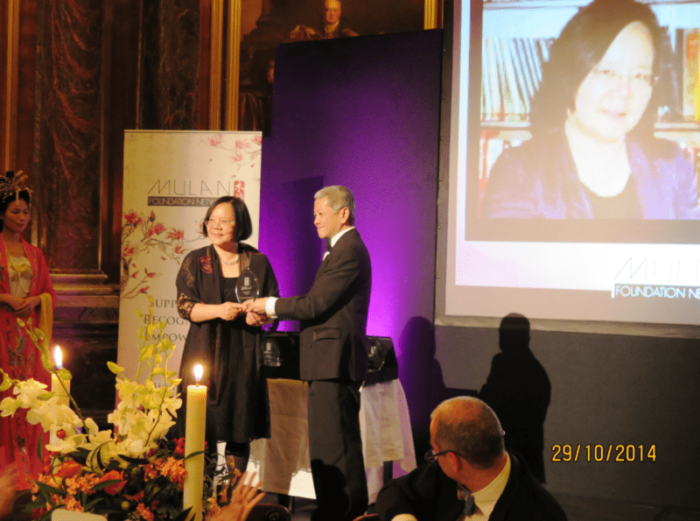
Director of CCPN Global received Mulan Award, 2014
Professor Xiangqun Chang, Director of CCPN Global, received a Mulan Award for her Contribution to Education by the Mulan Foundation Network on the 29th October 2014. The first annual Mulan Awards Dinner was held at the Drapers Hall to honour and recognise the achievement Chinese women. According to Mulan Foundation, it ‘aims to recognise and honour the achievements of Chinese women in the UK and elsewhere through Annual Awards and in the process build up a global network of top and successful Chinese women and young Chinese women on the way up, for networking, mentoring and to support and help each other as well as contribute to the wider community’.
I. Mulan Award Ceremony
Welcome and reception:

The guests were welcomed by Mei Sim Lai OBE DL, Chairman of Mulan Foundation Network; Dr Mee Ling Ng, OBE, the chair of the Awards’ judging panel; and Lady Katy Tse Blair MBE (from left to right at the top right picture). At the bottom left picture Mr Neil Clarke, CCPN Global volunteer, with Ms Xinran Xue, author of 7 books published in over 37 languages. She also worked at BBC World Service as a journalist, translated several important literary works into Chinese (including Pinter’s entire theatrical bibliography) and founded a charity – The Mothers’ Bridge of Love. At the bottom right shows Dr Thomas Clarke, Senior Teaching Fellow of Imperial College London, Trustee of CCPN Global, with Polly Yu, a Solicitor from Bloomsbury Law.
Dinner banquet:

Nearly 200 guests attended the Mulan Awards Dinner 2014 for honouring the achievements of Chinese women at the Drapers Hall. Attendees also included Ms Qingling Guo, an International Trade Adviser UK Trade & Investment (UKTI) in the bottom left picture); and Ms Elaine Pooke (bottom right), English Heritage’s Production Manager, who has over 25 years’ experience in the Printing and Publishing Industry, and helped in the design of CCPN Global’s new leaflet. She is also Managing Ambassador for the Mayor of London.
Awards presentation:

Dr Mee Ling OBE, Chair of judges of panel of the Mulan Awards announced that Dr Xiangqun Chang, Director of CCPN Global is the Winner for her contribution to education (top left), Professor Danny Quah of the London School of Economics and Political Science, presented the award to Professor Chang (top right and bottom left). Coincidentally, Professor Quah was Chairman of the Management Committee of CCPN (China in Comparative Perspective Network) at LSE before CCPN Global was registered as an academic charity in 2013. The picture at bottom right is Xiangqun with Mei Sim Lai OBE DL, Chairman of Mulan Foundation Network.
Family, friends, and colleagues:

Dr Xiangqun Chang with Mr William Franklin, Business Development Consultant, Sophis Approach Limited and Ms Ingrid Cranfield, formerly Councillor for Lower Edmonton ward, and Deputy Mayor of Enfield Council (Top left picture); Xiangqun with her supportive family on top right picture; from bottom right: Dr Chang and family with Prof. Quah and his wife.
II. A list of winners:

1. Young Achiever of the Year
Winner: Ms Yaoqian Shang, Birmingham Royal Ballet. Graduate of The Royal Ballet and winner of the Ninette de Valois award 2013.
2. Contribution to Education
Winner: Professor Xiangqun Chang, Director of CCPN Global, a UK-based academic society focusing on the study of China and the Chinese from a comparative perspective. Research Associate, SOAS, University of London. Holder of several professorial and senior fellowships at Renmin, Peking, Fudan and Sun Yat-Sen Universities in China.
3. Contribution to Arts and Culture
Winner: Ms Betty Yao MBE. Director of Credential International Arts Management, UKIP and Projects Director at Asia House, London.
Winner: Ms Di Xiao. International pianist at Birmingham Conservatoire. Winner of first prize Brant International Piano Competition 2007.

4. Contribution to Science and Technology
Winner: Dr Sharon Heng. Specialty Registrar, Addenbrookes Eye Unit, Cambridge University Hospital. Research into age related macular regeneration (AMD) and founder of CHEF (Chan Heng Eye Foundation), a charity providing rehabilitation support for the visually impaired members of the Chinese community in London.
5. Contribution to Business and Enterprise
Winner: Ms Carol Hui. General Counsel for Heathrow Airport Holdings (formally BAA). Director of Heathrow Airport Limited. Previous roles include GC for Amey and Deputy GC for BG Group. Winner of the European General Counsel of the Year 2008.
Commendation: Ms Teresa Li. Owner of The Jobwall, an online job board for job seekers and employers. Winner of an enterprise award from the Scottish Asian Women’s Association.
6. Contribution to Charitable Causes and Philanthropy
Winner: Ms Viola Wong. Managing Director of Confiserie Benji Limited. Founder and benefactor of Benji’s Centre. The charity provides professional speech therapy to over 680 children with disabilities and from disadvantaged background.

7. Contribution to Public Service and Community
Winner: Ms Catherine Zeng. Head of Financial Services, Trade and Investment, HM Treasury. Previous roles include: Senior Policy Adviser, Financial Regulation and Markets, HM Treasury.
Commendation: Ms Min Rose. Promoting and connecting up UK-China business, enterprise and academic partnerships with the University of Nottingham and the wider Chinese community.
8. Outstanding Contribution at the International level
Winner: Ms Jiang Bing, Deputy Director of GBCC (Great Britain China Centre). Contribution to major UK-China collaborations in the field of the development of China’s legal and judicial system, by working with the Supreme People’s Court, the Chinese Ministry of Justice and legal scholars in academic institutions.
Commendation: Ms Huilin Proctor, Head of China Desk, DLA Piper UK LLP. The development of Chinese Corporate Law and an arts and culture ambassador in facilitating exchange of cultural excellence between UK and China.
Click HERE to its Chinese page 全球中国比较研究会常向群会长荣获2014年“木兰奖”
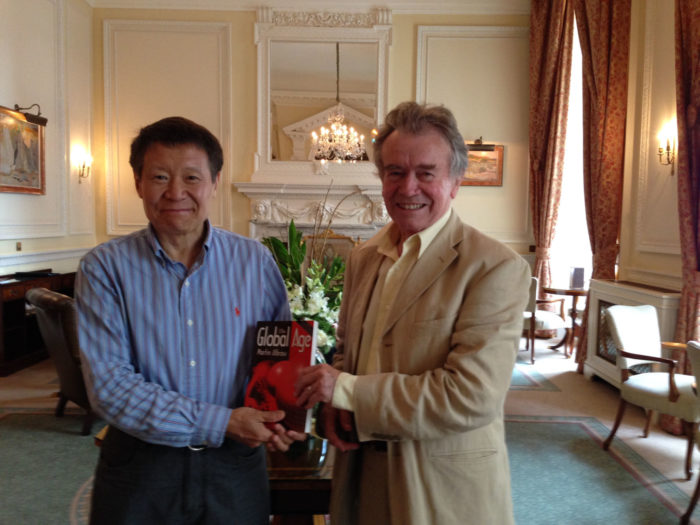
President of the Chinese Sociological Association, Professor LI Qiang, and His Wife’s Visit to the UK (20-25 July 2014)
On July 20, 2014, Professor LI Qiang (1950-2023), then Dean of the School of Social Sciences at Tsinghua University, traveled to the UK for a vacation with his wife, Zhang Hua [Note 1]. As a friend, I had arranged their 10-day itinerary in advance and accompanied them in London. Unfortunately, due to Mrs. Zhang catching a cold and developing a fever, they had to cut their vacation short and rescheduled their return flight on the afternoon of the 24th. This left many regrets but also provided me with unforgettable and wonderful memories. The following is a record of some of their visit.
On July 20th (Sunday), the Li couple arrived at London Heathrow Airport at 15:10 on flight BA38, then proceeded to check in at the Hilton London Hotel (located on Edgware Road but quite far from Edgware Station, which is near my home). A BBC Prom concert was arranged at 19:30 at the Royal Albert Hall, where the World Peace Orchestra, consisting of musicians from around the world, performed classical pieces by composers such as Beethoven and Mozart, as well as some music themed around world peace, expressing the harmonious coexistence of different cultures and nations through various famous pieces. Unfortunately, due to jet lag and fatigue, the Lis were unable to attend, so I and other friends appreciated it on their behalf.
On July 21st (Monday), we took a day trip to Wisley Gardens. On this day, the Li couple joined an activity that I had previously arranged with two friends. Wisley Gardens, part of the Royal Horticultural Society (RHS), is located 23 miles southwest of the Royal Botanic Gardens, Kew, in Surrey. It is one of the gardens owned and managed by the RHS and is considered one of the most influential horticultural gardens in the world. With its diverse plant collections, exquisite garden designs, and deep horticultural traditions, it has become a sanctuary for garden enthusiasts both in the UK and globally.

The first set of photos features some flowers I had never seen before (from left to right): Artichoke (Cynara cardunculus), a member of the thistle family originally from the Mediterranean region. The unopened flower buds are edible, and the open flowers are bright purple, valued for both their ornamental and economic qualities; Vanda, renowned for its large, colorful flowers, with this particular Vanda sporting purple spots, making it highly ornamental; Bird of Paradise (Strelitzia reginae), known for its unique shape and vibrant colors, with this plant displaying a combination of red, yellow, and green, making it very eye-catching; Spider Orchid (Brassia), named for its unique flower shape, with long, spidery petals and sepals; Spiral Ginger (Alpinia zerumbet), noted for its unique spiral stems and decorative leaves, widely used for ornamental purposes.
The next set of photos (from left to right): We encountered a Chinese pavilion called the ‘Butterfly Lovers Pavilion’ in Wisley Gardens. It was built in 2005 through a collaboration between the Shanghai Botanical Garden in China and the RHS. Initially designed for the Hampton Court Palace Flower Show that year, where it won a silver medal, the pavilion was later donated to Wisley Gardens as a permanent feature. The pavilion’s design was inspired by the classic Chinese love story ‘The Butterfly Lovers’ (Liang Shanbo and Zhu Yingtai). The design and construction were led by Professor LIU Tingfeng from the Landscape Design Department at Tianjin University, China. To commemorate the story, the pavilion’s six pillars are carved with butterfly motifs, symbolizing the transformation of the lovers into butterflies at the end of the legend. The construction materials were sourced from Zhejiang to ensure the pavilion’s authentic Chinese architectural style. The pavilion was built to celebrate Sino-British cooperation in horticulture and to introduce traditional Chinese garden art to Wisley Gardens, offering visitors a unique blend of Eastern and Western cultural experiences. The pavilion was designed and built by Chinese horticulturists and craftsmen who ensured that it seamlessly blended into Wisley Gardens’ natural environment.
As we were leaving Wisley Gardens, we took commemorative photos with my friends and Professor Li and his wife respectively.
On July 22nd (Tuesday), we spent a day touring central London.
We had arranged to meet Professor Martin Albrow, former president of the British Sociological Association, for lunch at 12:30, so our schedule was quite tight. Early in the morning, we took the Tube to the Tower of London and Tower Bridge. Due to time constraints, we didn’t enter but toured the area before boarding a sightseeing boat along the Thames towards Westminster (see following photos).

At Westminster Pier, we walked along Downing Street (with No. 10 being the official residence of the British Prime Minister), passing by Horse Guards Parade, Horse Guards Arch, and other sites, where we witnessed the Changing of the Guard (see following photos).
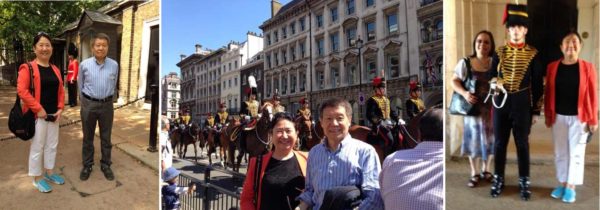
Afterward, we arrived at Trafalgar Square. Professor Li was particularly interested in the four bronze lion statues at the base of Nelson’s Column, one of Trafalgar Square’s most iconic features. He asked me to take a photo of him and his wife with one of the lions as the background. The contrast between the massive lion and the ‘small’ figures of the Lis in the photo led me to reflect. The lion, a symbol of strength, courage, and dignity in many cultures, perhaps served as a confirmation of self-identity and pride.
We were also intrigued by the blue rooster sculpture on the Fourth Plinth in the square. The Fourth Plinth was originally designed for a statue of King William IV, but due to funding issues, the statue was never completed. In 1999, the Fourth Plinth Project was launched, turning it into a platform for displaying contemporary art, with a new piece being installed every few years. The sculpture, titled ‘Hahn/Cock,’ was created by German artist Katharina Fritsch. Its bold color and form sparked widespread discussion and interest. The blue rooster symbolizes male strength and courage, while also carrying a satirical tone that questions the solemnity of traditional monuments. Fritsch described it as a humorous satire, challenging the gravity of other traditional statues in the square, making it a prime example of contemporary art in public spaces (see following photos).
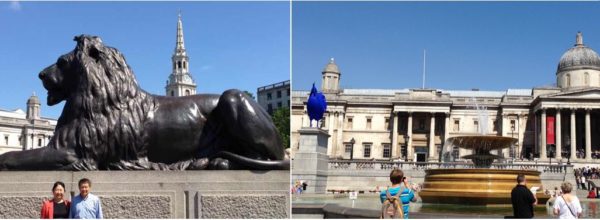
After leaving the square, Professor Li suggested visiting The British Academy. Founded in 1902, The British Academy is a national academic institution established to promote and support research in the humanities and social sciences. Its primary goal is to promote high standards of academic research, encourage scholarly debate, and support research that enhances understanding of human and social issues. The Academy is not open to the public, and one can only enter by attending an event or participating in a meeting. After taking a photo at the entrance, Professor Li suggested that we should organize events here in the future. [Note 2].
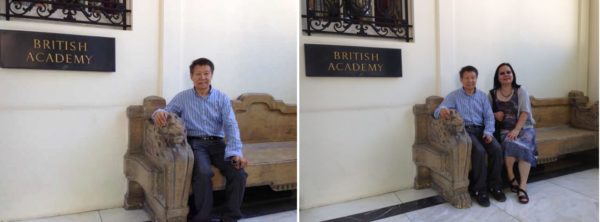
Our lunch with Martin Albrow was held at the Royal Automobile Club (RAC). This is one of Britain’s top private members’ clubs, offering dining, accommodation, fitness facilities, social events, and business meeting spaces. The RAC’s dining services are renowned for their high quality and exquisite cuisine, making it a key part of London’s high-end social life. Martin accompanied Professor Li and his wife on a tour of the club, where we exchanged ideas in the garden. After lunch, Martin presented Professor Li with his award-winning book, The Global Age (see following photos) [Note 3].

After lunch, we strolled through London and visited the London School of Economics, where we met with Dr. LIU Jiayan, a visiting fellow from Tsinghua University’s School of Architecture. She was conducting postdoctoral research under Professor Li’s supervision (see following photos). [Note 4]

We managed to be among the last visitors admitted to the British Museum before closing at 4 p.m. Professor Li asked me to take another photo of them in front of a large Assyrian lion relief. This famous Assyrian stone relief, likely from the ancient city of Nineveh, depicts scenes from the ‘Assyrian Lion Hunt,’ symbolizing the power and majesty of the Assyrian Empire. This photo again illustrates Professor Li’s identification with the symbolic attributes of the lion.
In the China Collection, we saw a large scroll painting (unfortunately, we did not photograph the exhibit label). The painting depicted landscapes, featuring mountains, rivers, and pine trees, intended to convey the artist’s reverence for nature and to express a sense of tranquility and harmony. In passing, I mentioned the idea of expanding the ‘China in Comparative Perspective’ approach at the London School of Economics to include a global perspective. This would not only involve comparing China with other countries and regions on a global scale but also conducting a comprehensive comparative study of China’s social transformations from past to present within a historical context. Methodologically speaking, the essential difference between the social science research conducted by Chinese scholars and that of their Western counterparts can be understood by grasping the essence of a Chinese scroll painting. [Note 5]
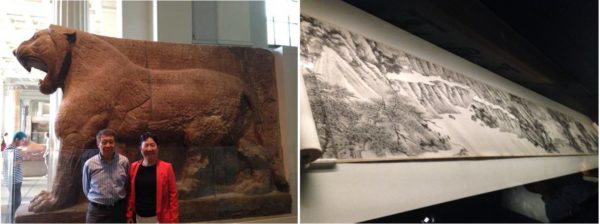
On July 23rd (Wednesday), the Li couple took a day trip to Windsor on their own, departing from Waterloo Station. They conducted a detailed tour of Windsor Castle. After their return to London, Mrs. Zhang developed a fever, and they decided to reschedule their flight to return to China early.
On July 24th (Thursday), the original plan was to go on a walk in the woods near my home and have an academic discussion, but due to their flight departing from Heathrow Airport at 16:45, we skipped the walk. Instead, we had a morning tea chat and lunch. The following photos were taken by Professor Li. At that time, taking photos and shared via WeChat was not very common, so we didn’t take a group photo, but there were individual photos of Mrs Zhang with my mother and me.
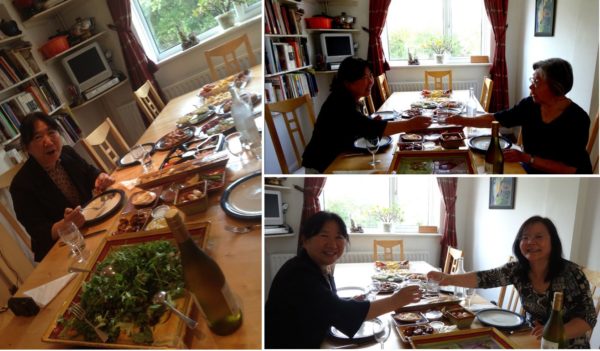
At around 2 pm., we met with LIU Jiayan and her son at Heathrow Airport’s Terminal 2. The child happily and proactively pushed the luggage cart, which everyone admired as a good educational approach. Before parting, we took a group photo in front of a colorful painting advertisement. Reflecting later, this photo carried profound and personal significance, symbolizing academic exchange, friendship, educational inheritance, and family bonds. It recorded an important moment in the scholars’ professional and personal lives, demonstrating their commitment to knowledge, nurturing students, and cherishing family.
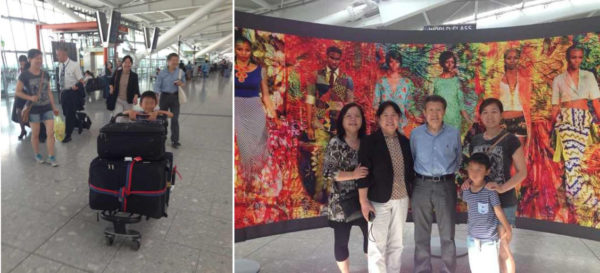
Notes:
- [1] In July 2014, Li Qiang was elected President of the Chinese Sociological Association. He was the sixth president since the association’s founding in 1979, following Fei Xiaotong, YUAN Fang, LU Xueyi, ZHENG Hangsheng, and LI Peilin. This blog was updated after visits by Tsinghua University’s School of Social Sciences and other universities in Beijing and Shanghai to the UK in July-August 2024.
- [2] Starting in 2015, the second to the eighth Global China Dialogue series were all held at this location until 2023.
- [3] Li Qiang also served as the Honorary Chinese President of the Global China Institute (alongside Martin). After the institute was renamed the Global China Academy and restructured into a worldwide fellowship, Li Qiang served as the Chinese chair of the Academy’s Council, alongside Professor Tony McEnery, former Interim Chief Executive of the UK’s Economic and Social Research Council (ESRC), which is equivalent to China’s National Philosophy and Social Sciences Foundation.
- [4] Professor Li, together with Mr. LI Tie, former Director of the China Center for Urban Development and Small Towns Reform, co-edited the ‘China Urbanization Studies Series,’ published by Global Century Press, with Dr. Liu serving as the Executive Editor.
- [5] Xiangqun Chang, Guanxi or Li shang wanglai? Reciprocity, Social Support Networks, & Social Creativity in a Chinese Village (Scholarly Publishing Business, Airiti Press Inc. 2010; Chinese editions 2009 and 2010): ‘In 2005 there was an exhibition of “China: Three Emperors (1662–1795)”. David Hockney, the Fellow of The Royal Academy of Arts, commented that the Chinese paintings deployed multiple perspective points in a single painting, which is different from the single perspective point in Western painting. For him, Western history of art has long neglected the beauty and sophistication of the Chinese scroll painting (A typical example is the Qingming Riverside Painting)’. From Hockney’s point of view, the scroll painting ‘bears close resemblance to cinema pictures by offering a sense of pleasure at being part of the painting. As the Chinese painting has no vanishing point, its viewer has to assume a participatory approach, rather than a static posture, through which to engage him or herself, including eyes, body and psyche into the story-telling and moving with the scroll part by part” (David Hockney, “A Difference of Perspective”, in “Three Emperors, 1662–1795”, RA Magazine, Winter, 2005). Chang believes that western social science is more focused on a detailed analysis of specific issues, while the Chinese way is to offer a combined approach to several issues together. Her ‘book is an attempt to present to its readers a huge scroll painting of the complicated relationships in the everyday life of a Chinese village. It is nonetheless not totally Chinese, just as sometimes in the West a few miniatures can be presented on one big wall. In this case they are embedded in the Chinese scroll. Hockney’s prescription of how to appreciate Chinese painting might be helpful for readers in their approach to this book’ (Chang, 2010, p42-43).
Xiangqun Chang, originally posted on July 30, 2014; updated on August 30, 2024.
Related pages:
- Click here to the Chinese page.
- Click here to view the page ‘GCA Life Fellow Korean Sociologist Professor HAN Sang-Jin Meeting Professor Xiangqun Chang at Seoul, January 2023.’
- Click here to the news ‘The Chinese Chair of the Global China Aacademy Council, Professor LI Qiang, passed away on the 12 December, 2023’.
- Click here to watch a video of Professor LI Qiang’s greeting for the launch of the Global China Academy as an academy at the 7th Global China Dialogue, on December 10th, 2021, at the British Academy.
- Click here to visit News and Blog.

中国社会学会会长李强教授携夫人访问英国 (2014年7月20-24日)
2014年7月20日,时任清华大学社会科学学院院长的李强教授(1950-2023)携夫人张华来英国度假【注释1】。我以朋友的身份提前安排了为期10天的行程,并在伦敦接待了他们。由于张老师感冒发烧,他们不得不中断假期,于24日下午提前改签机票回国,留下了许多遗憾,也给我留下了难忘和美好的回忆。以下记录了他们此次访问的部分内容.
7月20日(星期日),李强夫妇乘BA38航班于15:10抵达伦敦希思罗机场,随后前往Hilton London酒店入住(该酒店位于Edgware Road,但距离我家附近的Edgware Station较远)。预订了19:30在皇家阿尔伯特音乐厅(Royal Albert Hall)欣赏由世界和平乐团(World Peace Orchestra)的演奏会。这支乐团由来自世界各地的音乐家组成,演奏了贝多芬、莫扎特等作曲家的作品,以及一些具有世界和平主题的音乐作品,通过这些演奏表达了不同文化和民族的和谐共存。可惜,由于李老师夫妇有时差且较为疲劳,我和其他朋友代他们欣赏了音乐会。
7月21日(星期一),我们前往威斯利花园进行一日游。当天,李强夫妇加入了我和两位朋友之前安排好的活动。威斯利花园(Wisley Gardens, Royal Horticultural Society, RHS)位于距离皇家植物园邱园(Royal Botanic Gardens, Kew Garden)西南23英里的萨里郡,是英国皇家园艺学会拥有和管理的花园之一,也是世界上最具影响力的园艺花园之一。该花园以其丰富多样的植物、精美的园艺设计和深厚的园艺传统,成为了英国乃至全球园艺爱好者的圣地。

以上这组照片展示的是我之前未曾见过的花卉(从左至右):朝鲜蓟(Artichoke),一种属于菊科的植物,原产于地中海地区。未开花的花蕾可食用,开放的花朵呈鲜艳的紫色,具有观赏价值和经济价值;万代兰(Vanda),以其华丽的大花和多样的花色著称,这株万代兰的花朵上有紫色斑点,极具观赏价值;鹤望兰或天堂鸟花(Heliconia rostrata),以其独特的外形和鲜艳的颜色闻名,这株鹤望兰的花朵呈现红色、黄色和绿色的组合,非常具有观赏性;蜘蛛兰(Spider Orchid)或布拉索兰(Brassia),因其花朵形状奇特,长长的花瓣和唇瓣让人联想到蜘蛛的腿而得名;螺旋姜(Alpinia zerumbet),它的茎部有着独特的纹理和形状,呈现出螺旋状的结构,因其独特的外观和叶片而广泛用于观赏。
下组照片(从左至右):在威斯利花园(Wisley Gardens)内看到一个中式亭子,上面写着“蝶恋亭”(Butterfly Lovers Pavilion)。这是2005年由中国上海植物园与英国皇家园艺学会(Royal Horticultural Society, RHS)合作建造的。该亭子最初为当年的汉普顿宫花卉展(Hampton Court Palace Flower Show)而设计,并获得了银奖。建成后,它被捐赠给威斯利花园,成为了该园内的一个永久景点。这座亭子的设计灵感源自中国经典爱情故事《梁山伯与祝英台》。亭子的设计和施工由中国天津大学景观设计教授刘庭风负责。为了纪念这一传说,亭子的六根柱子上都雕刻有蝴蝶图案,象征着这对传说中的恋人最终化蝶的爱情故事。蝶恋亭的建造和放置地点旨在突出中国园林设计的哲学理念,特别是在与自然环境的融合方面。亭子的材料均从浙江运来,以确保其传统中国建筑风格得以完美呈现。建造蝶恋亭的主要目的是庆祝中英两国在园艺领域的合作,并将中国传统园林艺术引入到威斯利花园,为游客提供一种东西方文化融合的独特体验。该亭子的设计和施工由来自中国的园艺师和工匠负责,他们根据中国古典园林的建筑风格和工艺,将亭子完美地融入了威斯利花园的自然环境中。
当我们要离开威斯利花园时,分别与我的朋友和李强老师夫妇合影留念。
7月22日(星期二),伦敦市内一日游
我们与英国社会学学会前会长马丁·阿尔布劳教授约好了12:30的午餐会,行程相当紧凑。我们一大早乘地铁前往伦敦塔和塔桥,由于时间关系,我们没有进去参观。在附近浏览后,我们在码头登上了一艘朝威斯敏斯特方向行驶的泰晤士河观光船(见以下组图)。

到了威斯敏斯特码头,我们沿着唐宁街(10号是英国首相官邸)行走,经过皇家马厩(Horse Guards Parade)、伦敦骑兵卫队拱门(Horse Guards Arch)等地,观赏了换马仪式(见以下组图)。

随后,我们来到了特拉法加广场(Trafalgar Square)。李老师对广场上纳尔逊纪念柱(Nelson’s Column)基座四周的四座青铜狮子雕像表现出了浓厚兴趣。这些狮子雕像是特拉法加广场的标志性景观之一,李老师特别选取其中一只狮子为背景合影。我对于这张照片中巨大的狮子和“渺小”的李老师夫妇形成的对比产生了联想。狮子在许多文化中被视为力量、勇气和尊严的象征,在此地拍照或许是对自我认同的一种肯定和自豪。
我们也都对广场上第四基座(Fourth Plinth)上的蓝色公鸡雕塑产生了兴趣。第四基座最初是为威廉四世国王的雕像而设计的,但由于资金问题,雕像从未完成。1999年,第四基座项目启动,成为展示当代艺术作品的平台,每隔一段时间更换一件新的艺术作品。这座名为《大公鸡》(Hahn/Cock)的雕塑由德国艺术家Katharina Fritsch创作。雕塑以其大胆的颜色和形象引发了广泛的讨论和关注。蓝色公鸡象征着男性的力量和勇气,同时也带有讽刺意味,质疑传统纪念碑的严肃性。艺术家Fritsch将其描述为一种幽默的讽刺,挑战了广场上其他传统雕像的沉重感,成为当代艺术在公共空间中的一个典型例子(见以下组图)。

离开广场后,李老师建议去参观英国国家学术院(The British Academy)。该学院成立于1902年,旨在促进和支持人文学科与社会科学研究,是英国国家级学术机构。其主要目的是促进学术研究的高标准,推动学术讨论,并支持通过研究来增进对人类和社会问题的理解。学术院不对外开放,只有参加内部活动或会议才能进入。李老师在门口留影,并建议说,以后我们要在这里举办活动。【注释2】。

我们与马丁·阿尔布劳的午餐会安排在皇家汽车俱乐部(Royal Automobile Club,简称RAC)。这是英国顶级私人会员俱乐部,提供餐饮、住宿、健身、社交活动和商务会议空间。RAC的餐饮服务以其高品质和精致的菜肴而闻名,是伦敦高端社交生活的一部分。马丁陪同李强夫妇参观了俱乐部,我们在花园里交流,午餐后,马丁赠予李强他的获奖著作《全球时代》(The Global Age)一书(见下组图)。【注释3】

午餐后,我们漫步于伦敦街区,来到了伦敦经济学院,在那里与正在做访问学者的清华大学建筑学院刘佳燕博士会面。她在李强的指导下从事博士后研究。(见下组图)【注释4】。

下午4点前,我们赶在大英博物馆(The British Museum)关门前最后一批进入参观。李老师又让我为他们在一尊大狮子的浮雕前拍照。这是著名的亚述石雕之一,可能来自亚述古城尼尼微(Nineveh)的遗址,表现了“亚述狮子狩猎”(Assyrian Lion Hunt)场景的一部分,是亚述帝国力量和威严的象征。这张照片再次表明了李老师与狮子这一象征的认同。
在中国馆,我们看到了一幅大型卷轴画(可惜没有拍下展品的标注)。这幅画描绘了山水题材,表现了山川、流水、松树等自然景观,意在表达画家对自然的崇敬,传达出一种宁静和谐的意境。我顺便谈及了在伦敦经济学院的“中国比较视野”的基础上加上全球视野,不仅是全球性地将中国与其他国家和地区作比较性研究,而且是历史性地对中国社会从过去到现在的转型作全方位的比较研究。从方法论上讲,中国学者的社会科学的研究与西方同行的研究的本质 区别可以通过理解一幅中国画卷来理解。【注释5】。

7月23日(星期三),李老师夫妇自行从滑铁卢火车站前往温莎小镇进行一日游,并对温莎城堡进行了详细参观。回到伦敦后,张老师开始发烧,于是他们决定改签机票,提前回国。
7月24日(星期四),原本安排的是在我家附近的林子里徒步并进行学术交流,但由于李老师夫妇的飞机将于下午16:45从希思罗机场起飞,我们取消了徒步活动。上午茶聊,随后享用了午餐。以下照片是李老师拍的,当时微信拍照还不太普及,所以没有留下我们的合影,但留下了张老师分别与我母亲和我的合影。

我们大概在下午2点前与刘佳燕和她的儿子在希思罗机场T2汇合,孩子主动并开心地推着行李车,大家都对这种教育方式表示赞赏。临别前,我们在一幅彩画广告前合影。后来回想,这张合影具有深刻和个人化的寓意,象征了学术交流、友谊、教育传承以及家庭纽带。它记录了学者们在职业和个人生活中的一个重要时刻,体现了他们对知识的追求、对学生的培养以及对家庭的珍视。

注释:
- [1] 李强于2014年7月当选为中国社会学会会长。这是自1979年学会成立以来的第六任会长,继费孝通、袁方、陆学艺、郑杭生和李培林之后。这篇博客是于2014年7月28日写的,并在10年后的2024年7-8月间,清华大学社会科学院等京沪四所高校访问英国后更新的。
- [2] 从2015年开始,第二届全球中国对话至2023年的第八届全球中国对话都在此处举办。
- [3] 李强曾兼任全球中国研究院中方荣誉院长(与马丁并列),全球中国研究院更名为全球中国学术院并改制为院士制机构后,李强担任学术院理事会中方会长,并与英国社会与经济研究委员会(ESRC,相当于中国哲学社会科学基金会)前代理总裁Tony McEnery教授并列。
- [4]李强与中国城市和小城镇改革发展中心前主任李铁共同主编了环球世纪出版社出版的“中国城镇化研究丛书”,刘佳燕担任该丛书的执行编辑。
- [5]常向群:《关系抑或礼尚往来?——江村互惠社会支持网和社会创造的研究》(简体字版,2009年;繁体字版,2010年;英文版,2010)中作过解释:英国皇家美术学院院士大卫·霍克尼(David Hockney)在评论《中国:三个皇帝(1662—1795)》展览中的中国画时指出,与西方的油画所提供的单视点(a single perspective point)不同,中国的绘画在一幅作品中通常同时表现等距的多视点(multiple perspective points)。他认为,西方艺术史一直忽视了美丽而精致的中国卷轴画(典型的此类画如“清明上河图”,中国比较研究网站选中此画作为首页的主题之一,有表现这种思维方式的寓意,见上面的标幅。 在霍克尼看来,”中国的卷轴画有点像电影,给观赏者一种参与绘画作品的快感。进而解释道,由于中国的绘画没有消失点(a vanishing point),与其说是站着不动地欣赏西方的油画,赏画者在欣赏中国画时则必须变成画中的这个消失点。因此,在欣赏中国画时要成为画的一部分,其眼睛、身体,甚至心理等都要参与到故事情节中去,并随着画面的滚动从一部分移动到另一个部分(David Hockney, A Difference of Perspective, in ‘Three Emperors, 1662—1795’, RA Magazine, Winter, 2005)。常向群认为,‘粗线条来看,“西方”的社会科学的研究比较注重于对某一个问题的深入细致地分析,而中国式的研究则比较注重于把几个问题综合在一起来概括和 描述。本书所提供给读者的是一幅用文字表达的反映江村村民生活极其复杂的关系的巨幅卷轴画。但它不完全是中式的做法,有点像西方的将若干小幅的油画挂在一 面墙上的展示法,不过在此不是挂在墙上,而是镶拼在中式的卷轴画里。借助于霍克尼建议的欣赏中国画的方法也许会有助于读者耐心地读完此书。’ (常:2009年,第15页;2010年,第39页)。
常向群,2014年7月30首发;2024年8月30更新。
相关页面:

